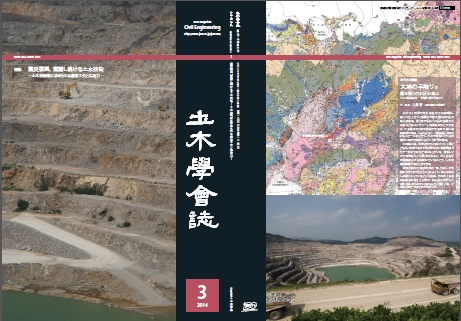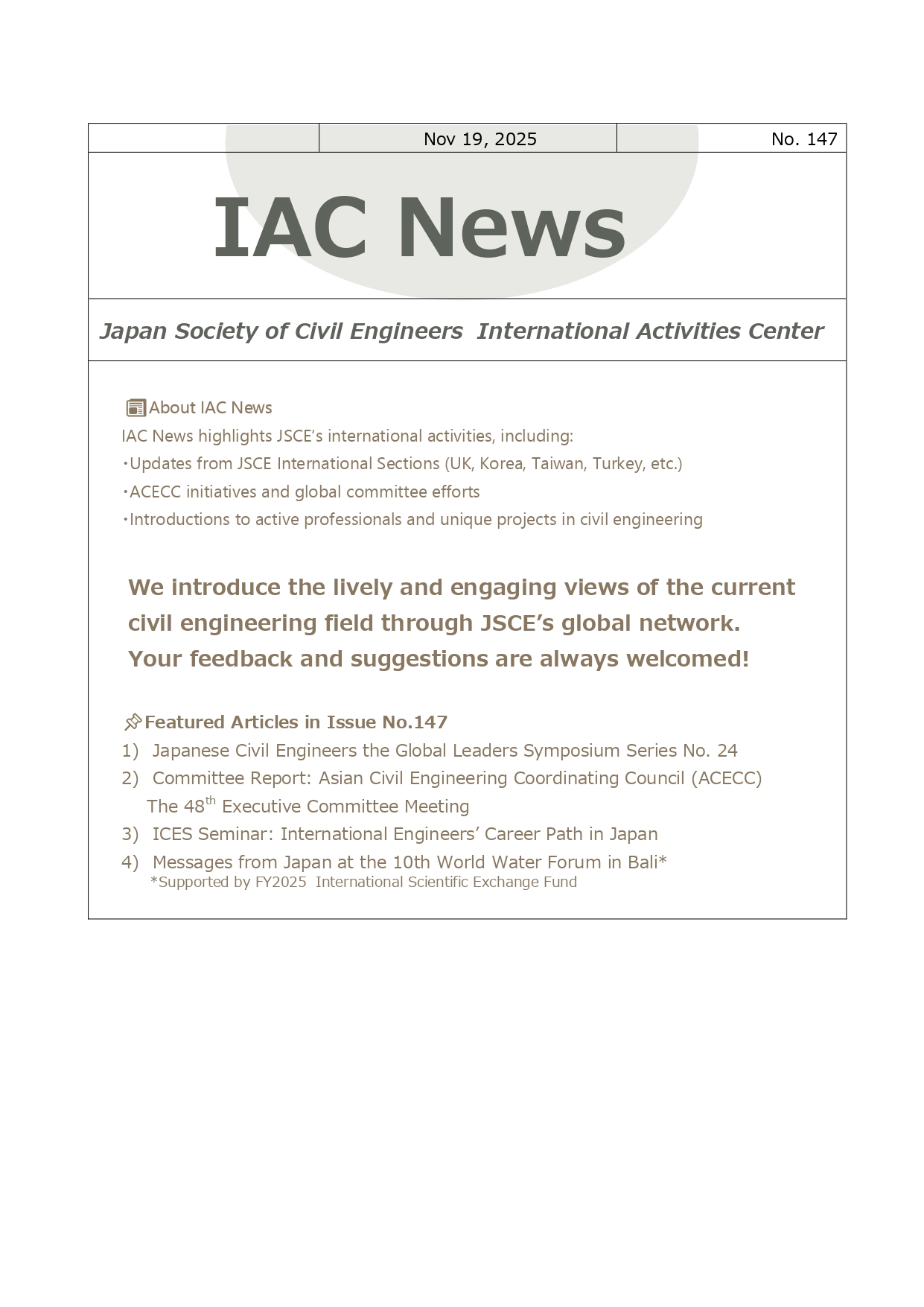Magazine Vol.99 No.3 Mar.2014
Latest Magazine
vol.99 No.3 Mra. 2014

No.3 2014
Feature Articles : Recent Efforts Civil Engineering for Post-Earthquake Restoration -Demands on Civil Engineers' Originality and Creativity-
It is three years after the March 11, 2011 Great East Japan Earthquake. The recovery of the affected areas has moved to a full-scale recovery stage from a restoration stage focusing on debris disposal. However, several serious issues have impeded the recovery plan. These issues, which include difficulties in consensus building between related organizations and local residents in the reconstruction of embankments devastated by the tsunami, a standstill of recovery process due to the delay of decontamination, and leakage of contaminated water from the TEPCO Fukushima Daiichi nuclear power plant, will lead to an uncertain future.
Under extremely limited time constraints and severe construction conditions, the present achievements in restoration and recovery could not be accomplished without the efforts of civil engineers who flexibly apply various technical skills. When confronting the unprecedented large-scale damage and vast amount of construction work, in order to overcome the seemingly impossible situation, strong technical skills backed by experience, and determination of engineers to make full use of their skills, are believed to be essential.
This special feature, focusing on three topics concerning the Great East Japan Earthquake, namely “Countermeasures and Lessons from Damage due to Tsunami”, “Decontamination and Response to Radioactive Contamination”, “Plans and the Possibility of Disaster Waste Treatment”, introduces selected cases of recovery projects that are driven by civil engineering technology.
The 2011 Great East Japan Earthquake will not be the final challenging earthquake and tsunami. Civil engineers in Japan have already started taking measures to prevent catastrophic consequences from the expected Great Nankai Trough earthquake. It is our intention that this issue will motivate and assist all civil engineers to consider their own missions, and visualize future possibilities.
≪Index≫
(02) Admiration of Civil Engineering Heritages by JSCE:Civil Engineering Heritage Sites Selection:Twin Gates for the Canal and Sand Flushing on the Kajikawa River -The Speakers about Flood Control History in the upper Niigata Plain
CHINO Yasuaki
(04) Feature articles: Recent Efforts Civil Engineering for Post-Earthquake Restoration -Demands on Civil Engineers' Originality and Creativity-
(06) The Contribution of Civil Engineering Technology to the Great East Japan Earthquake Restoration
KAJIWARA Yasuyuki, NAKAI Toshiro, HISADA Makoto
(10) Consideration to the Resiliency for Breakwaters
ARIKAWA Taro
(14) Try to improve the resistance of tsunami and seismic performance by the Geosynthetic-Reinforced Soil integral bridge at the revived bridges
KODA Fumio, SHINDO Yoshinori
(16) Tsunami protection wall of Hamaoka Nuclear Power Station -Construction in series by utilizing multiple technologies-
WANI Masaaki
(18) Civil Engineering Technology for Off-site Decontamination and Control of Radiocesium
ENDO Kazuto
(22) An Autonomous Driving Control System of Construction Equipments in Radioactive Area
MIURA Satoru, JIN Satoru
(24) Execution method of cement mixed soils for containing fluid mud
SHINSHA Hiroshi, HORIUCHI Tomomasa
(26) Disaster debris and recovered soils
KATSUMI Takeshi
(30) The use of disaster waste in seawall construction Application of the CSG (Cemented Sand and Gravel) dam construction method
OKEDA Takashi
(32) Upcycling of debris residue for the reconstruction in the affected areas -Joint development of the Upcycle Block-
KANO Toshiyuki
(34) Further Studies for civil engineers' efforts for the postearthquake restoration
(36) Feature articles 2: Three years after the Great East Japan Earthquake -The present situation of Fukushima Prefecture and the efforts towards restoration and recovery-
(38) What Civil Engineers can do now at Fukushima?
HASHIMOTO Kotarou, SHUTO Nobuo, WATANABE Hiroki,
YOSHIZAKI Osamu
(44) Current Activity of JSCE Committee on Countermeasures for Contaminated Water of Fukushima Daiichi Nuclear Power Plant
MARUYAMA Kyuichi
(48) “Another” Geo-environmental Problem caused by Radioactive Contamination and Approach to solve in Fukushima
KOMINE Hideo, ISOMATSU Norihiko, ANDO Junya, TAKAHATA Osamu
(52) Actual situation of "Reconstruction Project Plan" in coastal areas of Iwaki City, Fukushima prefecture
OKADA Tomohide
(56) JSCE Magazine -A Retrospective Look Over the Past 99 Issues Era of Comprehensive national development plan and Economic growth.
HASHIMOTO Masako
(60 )Letters from Tohoku Messages from single girls over 18 years old in Fukushima - The activities and memories at “GIRLS LIFE LABO
NITTO Maki
(64) Working Abroad Toward the establishment of sustainable road maintenance framework from the viewpoint of experiences as a JICA long-term expert in Kenya
NISHIBAYASHI Motohiko
(66) Learns from Civil Engineers who endeavors in Reconstruction 68 Committee Report The Committee on ISO Affairs in Civil Engineering
MATSUI Kenji
(72) Studying Abroad Project Management studied in UK university -Utilizing the various experiences in developing countries
NAKAJIMA Tsuyoshi
(73) Book review
(74) JSCE Member's Report A Report on Development of Rectangular Shield Tunneling Technology -Paddle Shield- and its Application to a River-Crossing Tunnel in MOBARA, Chiba
NAKAYA Takehiko
(76) Reviewing January issue
(78) Advisers' Column
(80) International Activities Center
(88) JSCE Updates
(107) JSCE Calender
(110) Next Issues
≪Back Number≫

